Social Sustainability and Resilience in Supply Chains of Latin America on COVID-19 Times: Classification Using Evolutionary Fuzzy Knowledge
Abstract
:1. Introduction
- Fuzzy mathematical programming that aims at operational optimization.
- Fuzzy multi-criteria decision-making methods.
- Fuzzy inference systems using expert knowledge or systematic mathematical tuning.
2. Methodology
- Validation of the measurement model in terms of its validity and individual consistency and constructs and, finally, simplifying the model with latent measures and second-order constructs.
- The application of the fuzzy evolutionary approach.
2.1. Measurement Constructs
2.2. Sampling and Collection of Information
2.3. Database and Feature Selection for Machine Learning
2.4. Fuzzy Logic Basics
2.5. The Fuzzy Inference System
2.6. Evolving Knowledge through a Genetic Algorithm
3. Experimental Setup
4. Results
5. Discussion and Conclusions
Author Contributions
Funding
Institutional Review Board Statement
Informed Consent Statement
Data Availability Statement
Conflicts of Interest
Abbreviations
| AVE | Average Variance Extracted |
| EA | Evolutionary Algorithm |
| FIS | Fuzzy Inference System |
| GA | Genetic Algorithm |
| HTMT | Heterotrait-Monotrait |
References
- Tarigan, Z.J.H.; Siagian, H.; Jie, F. Impact of Internal Integration, Supply Chain Partnership, Supply Chain Agility, and Supply Chain Resilience on Sustainable Advantage. Sustainability 2021, 13, 5460. [Google Scholar] [CrossRef]
- He, L.; Wu, Z.; Xiang, W.; Goh, M.; Xu, Z.; Song, W.; Ming, X.; Wu, X. A novel Kano-QFD-DEMATEL approach to optimise the risk resilience solution for sustainable supply chain. Int. J. Prod. Res. 2021, 59, 1714–1735. [Google Scholar] [CrossRef]
- Fahimnia, B.; Jabbarzadeh, A. Marrying supply chain sustainability and resilience: A match made in heaven. Transp. Res. Part Logist. Transp. Rev. 2016, 91, 306–324. [Google Scholar] [CrossRef]
- Hooks, T.; Macken-Walsh, Á.; McCARTHY, O.; Power, C. Farm level viability, sustainability and resilience: A focus on co-operative action and values-based supply chains. Stud. Agric. Econ. 2017, 119, 123–129. [Google Scholar] [CrossRef] [Green Version]
- Das, K. Integrating lean, green, and resilience criteria in a sustainable food supply chain planning model. Int. J. Math. Eng. Manag. Sci. 2019, 4, 259–275. [Google Scholar] [CrossRef]
- Ivanov, D. Revealing interfaces of supply chain resilience and sustainability: A simulation study. Int. J. Prod. Res. 2018, 56, 3507–3523. [Google Scholar] [CrossRef] [Green Version]
- Croom, S.; Vidal, N.; Spetic, W.; Marshall, D.; McCarthy, L. Impact of social sustainability orientation and supply chain practices on operational performance. Int. J. Oper. Prod. Manag. 2018, 38, 2344–2366. [Google Scholar] [CrossRef] [Green Version]
- Mani, V.; Jabbour, C.J.C.; Mani, K.T. Supply chain social sustainability in small and medium manufacturing enterprises and firms’ performance: Empirical evidence from an emerging Asian economy. Int. J. Prod. Econ. 2020, 227, 107656. [Google Scholar] [CrossRef]
- Sudusinghe, J.I.; Seuring, S. Social Sustainability Empowering the Economic Sustainability in the Global Apparel Supply Chain. Sustainability 2020, 12, 2595. [Google Scholar] [CrossRef] [Green Version]
- Sajjad, A. The COVID-19 pandemic, social sustainability and global supply chain resilience: A review. Corp. Gov. Int. J. Bus. Soc. 2021, 21, 1142–1154. [Google Scholar] [CrossRef]
- Goodarzian, F.; Navaei, A.; Ehsani, B.; Ghasemi, P.; Muñuzuri, J. Designing an integrated responsive-green-cold vaccine supply chain network using Internet-of-Things: Artificial intelligence-based solutions. Ann. Oper. Res. 2022, 1–45. [Google Scholar] [CrossRef]
- Silva, M.E.; Silvestre, B.S.; Del Vecchio Ponte, R.C.; Cabral, J.E.O. Managing micro and small enterprise supply chains: A multi-level approach to sustainability, resilience and regional development. J. Clean. Prod. 2021, 311, 127567. [Google Scholar] [CrossRef]
- Trautrims, A.; Schleper, M.C.; Cakir, M.S.; Gold, S. Survival at the expense of the weakest? Managing modern slavery risks in supply chains during COVID-19. J. Risk Res. 2020, 23, 1067–1072. [Google Scholar] [CrossRef]
- Mwangi, G.M.; Despoudi, S.; Espindola, O.R.; Spanaki, K.; Papadopoulos, T. A planetary boundaries perspective on the sustainability: Resilience relationship in the Kenyan tea supply chain. Ann. Oper. Res. 2021, 18, 1–35. [Google Scholar] [CrossRef]
- Soleimani, H.; Govindan, K.; Saghafi, H.; Jafari, H. Fuzzy multi-objective sustainable and green closed-loop supply chain network design. Comput. Ind. Eng. 2017, 109, 191–203. [Google Scholar] [CrossRef]
- Bandeira, R.A.; D’Agosto, M.A.; Ribeiro, S.K.; Bandeira, A.P.; Goes, G.V. A fuzzy multi-criteria model for evaluating sustainable urban freight transportation operations. J. Clean. Prod. 2018, 184, 727–739. [Google Scholar] [CrossRef]
- Djekic, I.; Smigic, N.; Glavan, R.; Miocinovic, J.; Tomasevic, I. Transportation sustainability index in dairy industry—Fuzzy logic approach. J. Clean. Prod. 2018, 180, 107–115. [Google Scholar] [CrossRef]
- Rajak, S.; Vinodh, S. Application of fuzzy logic for social sustainability performance evaluation: A case study of an Indian automotive component manufacturing organization. J. Clean. Prod. 2015, 108, 1184–1192. [Google Scholar] [CrossRef]
- Cao, Y.; Wang, S.; Yi, L.; Zhou, J. A Social Sustainability Assessment Model for Manufacturing Systems Based on Ergonomics and Fuzzy Inference System. In Sustainable Design and Manufacturing 2016; Setchi, R., Howlett, R.J., Liu, Y., Theobald, P., Eds.; Springer International Publishing: Cham, Switzerland, 2016; pp. 639–648. [Google Scholar] [CrossRef]
- Hendiani, S.; Bagherpour, M. Developing an integrated index to assess social sustainability in construction industry using fuzzy logic. J. Clean. Prod. 2019, 230, 647–662. [Google Scholar] [CrossRef]
- Rostamnezhad, M.; Nasirzadeh, F.; Khanzadi, M.; Jarban, M.J.; Ghayoumian, M. Modeling social sustainability in construction projects by integrating system dynamics and fuzzy-DEMATEL method: A case study of highway project. Eng. Constr. Archit. Manag. 2020, 27, 1595–1618. [Google Scholar] [CrossRef]
- Baghizadeh, K.; Pahl, J.; Hu, G. Closed-Loop Supply Chain Design with Sustainability Aspects and Network Resilience under Uncertainty: Modelling and Application. Math. Probl. Eng. 2021, 2021, 9951220. [Google Scholar] [CrossRef]
- Lotfi, R.; Kargar, B.; Rajabzadeh, M.; Hesabi, F.; Özceylan, E. Hybrid fuzzy and data-driven robust optimization for resilience and sustainable health care supply chain with vendor-managed inventory approach. Int. J. Fuzzy Syst. 2022, 24, 1216–1231. [Google Scholar] [CrossRef]
- Tsao, Y.C.; Thanh, V.V.; Lu, J.C.; Yu, V. Designing sustainable supply chain networks under uncertain environments: Fuzzy multi-objective programming. J. Clean. Prod. 2018, 174, 1550–1565. [Google Scholar] [CrossRef]
- Kiani Mavi, R.; Standing, C. Critical success factors of sustainable project management in construction: A fuzzy DEMATEL-ANP approach. J. Clean. Prod. 2018, 194, 751–765. [Google Scholar] [CrossRef]
- Pislaru, M.; Herghiligiu, I.V.; Robu, I.B. Corporate sustainable performance assessment based on fuzzy logic. J. Clean. Prod. 2019, 223, 998–1013. [Google Scholar] [CrossRef]
- Đurić, G.; Todorović, G.; Đorđević, A.; Tišma, A.B. A New Fuzzy Risk Management Model for Production Supply Chain Economic and Social Sustainability. Econ.-Res.-Ekon. Istraživanja 2019, 32, 1697–1715. [Google Scholar] [CrossRef] [Green Version]
- Yıldızbaşı, A.; Öztürk, C.; Efendioğlu, D.; Bulkan, S. Assessing the social sustainable supply chain indicators using an integrated fuzzy multi-criteria decision-making methods: A case study of Turkey. Environ. Dev. Sustain. 2021, 23, 4285–4320. [Google Scholar] [CrossRef]
- Nayeri, S.; Ali Torabi, S.; Tavakoli, M.; Sazvar, Z. A multi-objective fuzzy robust stochastic model for designing a sustainable-resilient-responsive supply chain network. J. Clean. Prod. 2021, 311, 127691. [Google Scholar] [CrossRef]
- Koza, J.R. Genetic Programming on the Programming of Computers by Means of Natural Selection; MIT Press: Cambridge, MA, USA, 1992. [Google Scholar]
- Bäck, T.; Fogel, D.B.; Michalewicz, Z. Evolutionary Computation 1: Basic Algorithms and Operators; CRC Press: Boca Raton, FL, USA, 2018. [Google Scholar]
- Holland, J.H. Genetic algorithms. Sci. Am. 1992, 267, 66–73. [Google Scholar] [CrossRef]
- Rajasekaran, S.; Pai, G.V. Neural Networks, Fuzzy Logic and Genetic Algorithm: Synthesis and Applications; PHI Learning Pvt. Ltd.: New Delhi, India, 2003. [Google Scholar]
- Santiago, A.; Dorronsoro, B.; Nebro, A.J.; Durillo, J.J.; Castillo, O.; Fraire, H.J. A novel multi-objective evolutionary algorithm with fuzzy logic based adaptive selection of operators: FAME. Inf. Sci. 2019, 471, 233–251. [Google Scholar] [CrossRef]
- Santiago, A.; Dorronsoro, B.; Fraire, H.J.; Ruiz, P. Micro-Genetic algorithm with fuzzy selection of operators for multi-Objective optimization: μFAME. Swarm Evol. Comput. 2021, 61, 100818. [Google Scholar] [CrossRef]
- Hajek, P.; Novotny, J. Fuzzy Rule-Based Prediction of Gold Prices using News Affect. Expert Syst. Appl. 2022, 193, 116487. [Google Scholar] [CrossRef]
- Hühn, J.; Hüllermeier, E. FURIA: An algorithm for unordered fuzzy rule induction. Data Min. Knowl. Discov. 2009, 19, 293–319. [Google Scholar] [CrossRef] [Green Version]
- Achouri, M.; Zennir, Y.; Tolba, C. Fuzzy-PI Conroller Tuned with GWO, WOA and TLBO for 2 DOF Robot Trajectory Control. Alger. J. Signals Syst. 2022, 7, 1–6. [Google Scholar] [CrossRef]
- Károlyi, G.; Pózna, A.I.; Hangos, K.M.; Magyar, A. An Optimized Fuzzy Controlled Charging System for Lithium-Ion Batteries Using a Genetic Algorithm. Energies 2022, 15, 481. [Google Scholar] [CrossRef]
- Ahmedov, S.; Amirjanov, A. Genetic-fuzzy logic model for a non-invasive measurement of a stroke volume. Comput. Methods Programs Biomed. 2021, 203, 106046. [Google Scholar] [CrossRef]
- Priya, R.; Ramesh, D.; Udutalapally, V. NSGA-2 Optimized Fuzzy Inference System for Crop Plantation Correctness Index Identification. IEEE Trans. Sustain. Comput. 2022, 7, 172–188. [Google Scholar] [CrossRef]
- Fernández, J.P.; Vargas, M.A.; García, J.M.V.; Carrillo, J.A.C.; Aguilar, J.J.C. Coevolutionary Optimization of a Fuzzy Logic Controller for Antilock Braking Systems Under Changing Road Conditions. IEEE Trans. Veh. Technol. 2021, 70, 1255–1268. [Google Scholar] [CrossRef]
- Robles-Velasco, A.; Muñuzuri, J.; Onieva, L.; Cortés, P. An evolutionary fuzzy system to support the replacement policy in water supply networks: The ranking of pipes according to their failure risk. Appl. Soft Comput. 2021, 111, 107731. [Google Scholar] [CrossRef]
- Hoffmann, F. Evolutionary algorithms for fuzzy control system design. Proc. IEEE 2001, 89, 1318–1333. [Google Scholar] [CrossRef]
- Kang, S.J.; Woo, C.H.; Hwang, H.S.; Woo, K. Evolutionary design of fuzzy rule base for nonlinear system modeling and control. IEEE Trans. Fuzzy Syst. 2000, 8, 37–45. [Google Scholar] [CrossRef]
- Huang, Y.C.; Yang, H.T.; Huang, C.L. Developing a new transformer fault diagnosis system through evolutionary fuzzy logic. IEEE Trans. Power Deliv. 1997, 12, 761–767. [Google Scholar] [CrossRef]
- Koutsojannis, C.; Hatzilygeroudis, I. Fuzzy-Evolutionary Synergism in an Intelligent Medical Diagnosis System. In Knowledge-Based Intelligent Information and Engineering Systems; Gabrys, B., Howlett, R.J., Jain, L.C., Eds.; Springer: Berlin/Heidelberg, Germany, 2006; Volume 4252, pp. 1313–1322. [Google Scholar] [CrossRef] [Green Version]
- Kim, S.Y.; Oh, S.Y. A driver adaptive lane departure warning system based on image processing and a fuzzy evolutionary technique. In Proceedings of the IEEE IV2003 Intelligent Vehicles Symposium. Proceedings (Cat. No.03TH8683), Columbus, OH, USA, 9–11 June 2003; pp. 361–365. [Google Scholar] [CrossRef]
- Nawa, N.; Furuhashi, T. Fuzzy system parameters discovery by bacterial evolutionary algorithm. IEEE Trans. Fuzzy Syst. 1999, 7, 608–616. [Google Scholar] [CrossRef]
- Hwang, G.H.; Kim, D.W.; Lee, J.H.; An, Y.J. Design of fuzzy power system stabilizer using adaptive evolutionary algorithm. Eng. Appl. Artif. Intell. 2008, 21, 86–96. [Google Scholar] [CrossRef]
- Chang, X.; Lilly, J. Evolutionary design of a fuzzy classifier from data. IEEE Trans. Syst. Man Cybern. Part B 2004, 34, 1894–1906. [Google Scholar] [CrossRef]
- Shi, Y.; Eberhart, R.; Chen, Y. Implementation of evolutionary fuzzy systems. IEEE Trans. Fuzzy Syst. 1999, 7, 109–119. [Google Scholar] [CrossRef] [Green Version]
- Cordón, O. A historical review of evolutionary learning methods for Mamdani-type fuzzy rule-based systems: Designing interpretable genetic fuzzy systems. Int. J. Approx. Reason. 2011, 52, 894–913. [Google Scholar] [CrossRef] [Green Version]
- Fukuda, T.; Kubota, N. An intelligent robotic system based on a fuzzy approach. Proc. IEEE 1999, 87, 1448–1470. [Google Scholar] [CrossRef]
- Wacker, J.G. A definition of theory: Research guidelines for different theory-building research methods in operations management. J. Oper. Manag. 1998, 16, 361–385. [Google Scholar] [CrossRef]
- Mandal, S.; Dubey, R.K. Role of tourism IT adoption and risk management orientation on tourism agility and resilience: Impact on sustainable tourism supply chain performance. Int. J. Tour. Res. 2020, 22, 800–813. [Google Scholar] [CrossRef]
- Heeler, R.M.; Ray, M.L. Measure Validation in Marketing. J. Mark. Res. 1972, 9, 361–370. [Google Scholar] [CrossRef]
- Sekaran, U.; Bougie, R. Research Methods for Business: A Skill Building Approach; John Wiley & Sons: Chichester, UK, 2016. [Google Scholar]
- Ringle, C.; Wende, S.; Becker, J.M. SmartPLS 3; SmartPLS GmbH: Schleswig-Holstein, Germany, 2015; Available online: http://www.smartpls.com (accessed on 1 January 2022).
- Zadeh, L. Fuzzy sets. Inf. Control 1965, 8, 338–353. [Google Scholar] [CrossRef] [Green Version]
- Sabri, N.; Aljunid, S.; Salim, M.; Badlishah, R.; Kamaruddin, R.; Malek, M.A. Fuzzy Inference System: Short Review and Design. Int. Rev. Autom. Control 2013, 6, 441–449. [Google Scholar]
- Hair, J.F.; Risher, J.J.; Sarstedt, M.; Ringle, C.M. When to use and how to report the results of PLS-SEM. Eur. Bus. Rev. 2019, 31, 2–24. [Google Scholar] [CrossRef]
- Henseler, J.; Ringle, C.M.; Sarstedt, M. A new criterion for assessing discriminant validity in variance-based structural equation modeling. J. Acad. Mark. Sci. 2015, 43, 115–135. [Google Scholar] [CrossRef] [Green Version]
- Edwards, J.R. Multidimensional Constructs in Organizational Behavior Research: An Integrative Analytical Framework. Organ. Res. Methods 2001, 4, 144–192. [Google Scholar] [CrossRef]
- Wang, C.N.; Nguyen, N.A.T.; Dang, T.T.; Lu, C.M. A Compromised Decision-Making Approach to Third-Party Logistics Selection in Sustainable Supply Chain Using Fuzzy AHP and Fuzzy VIKOR Methods. Mathematics 2021, 9, 886. [Google Scholar] [CrossRef]
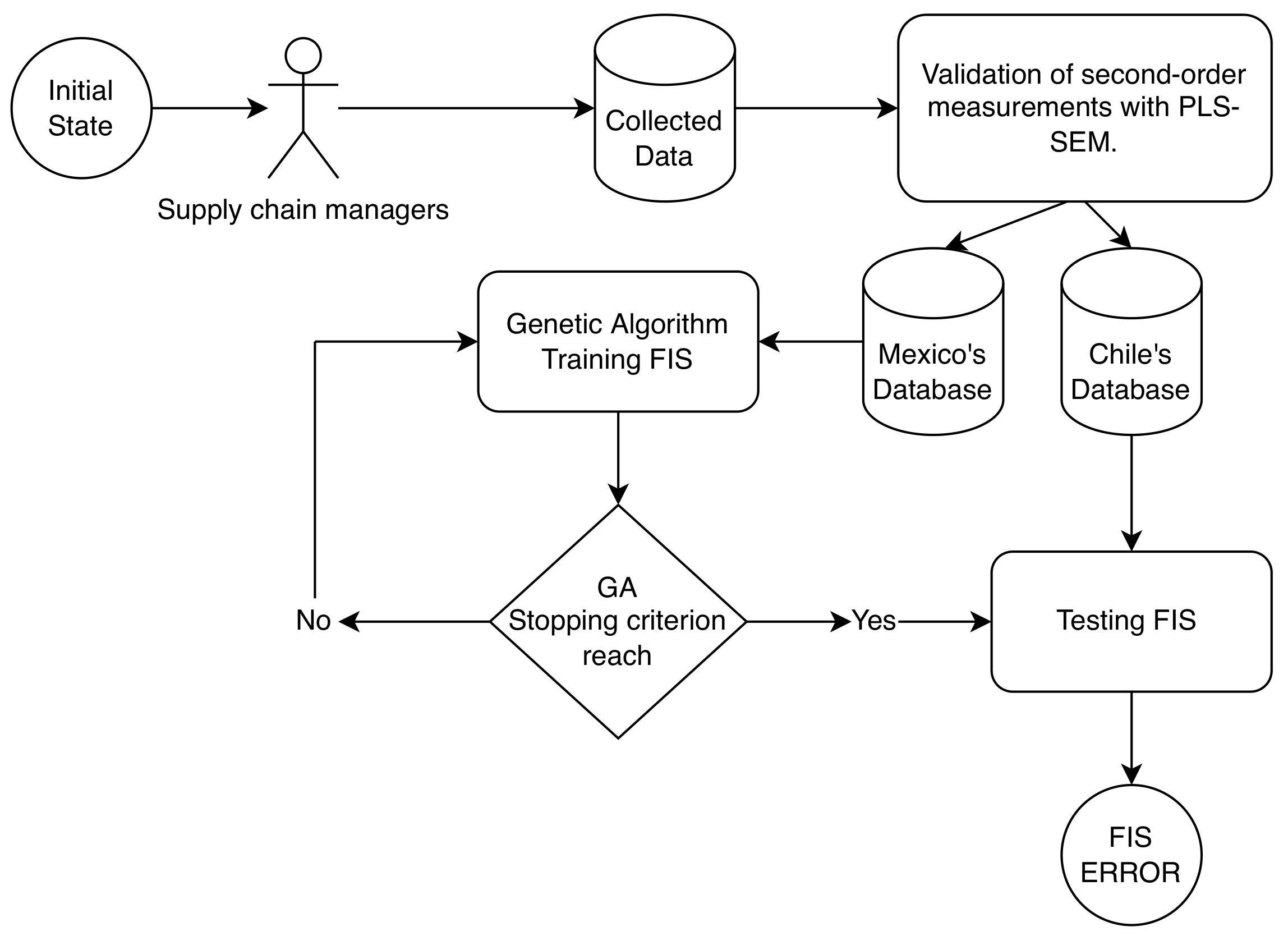
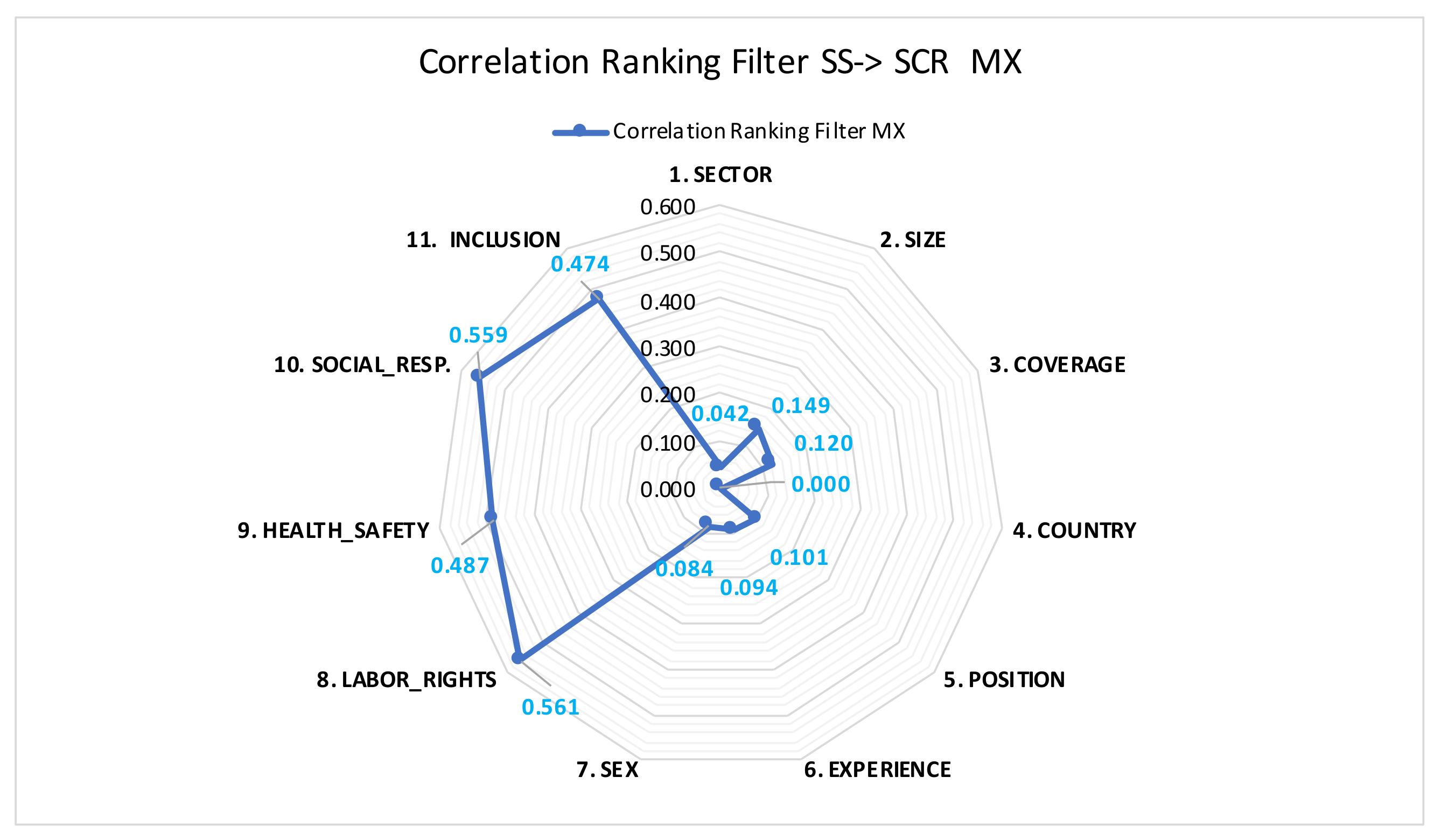
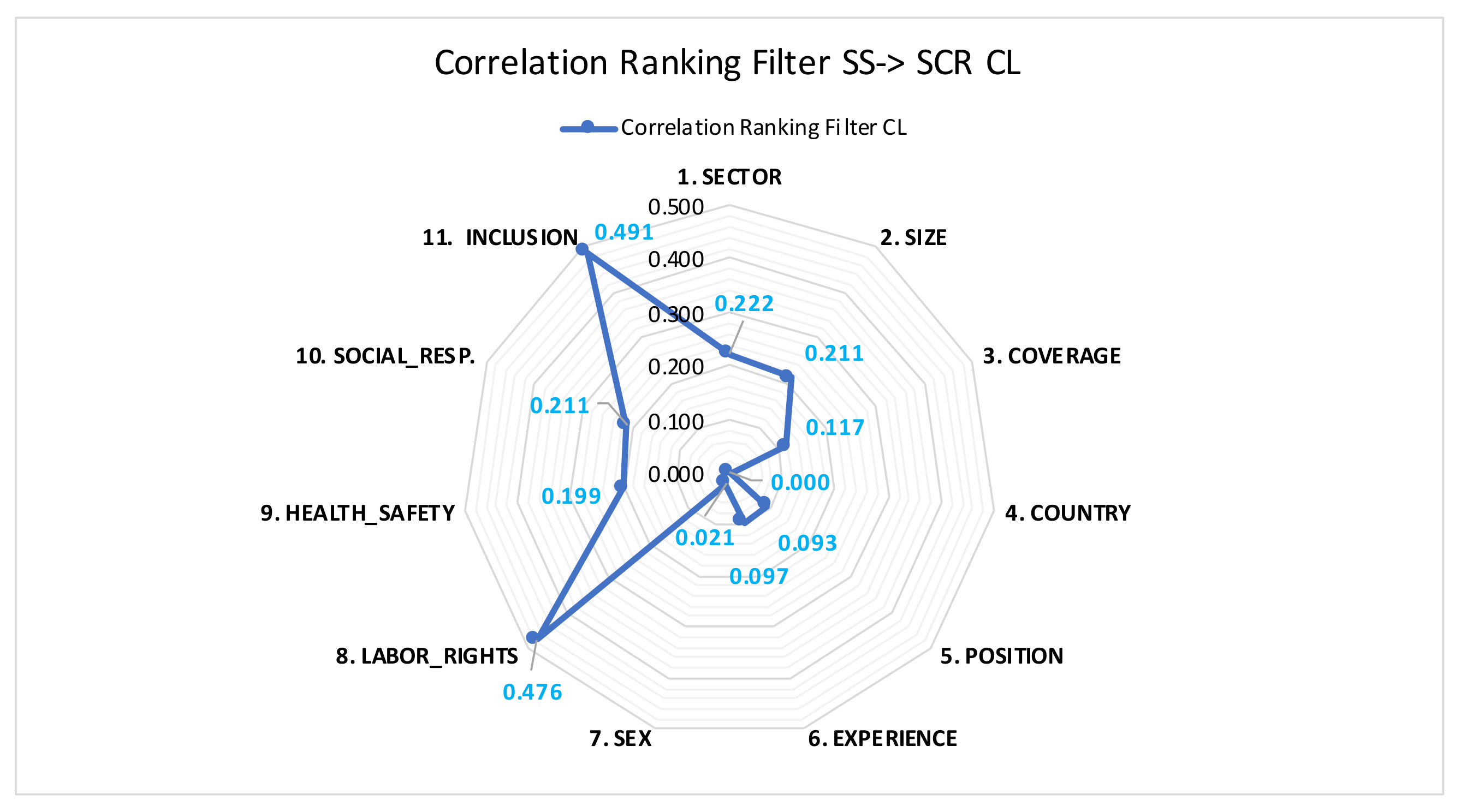
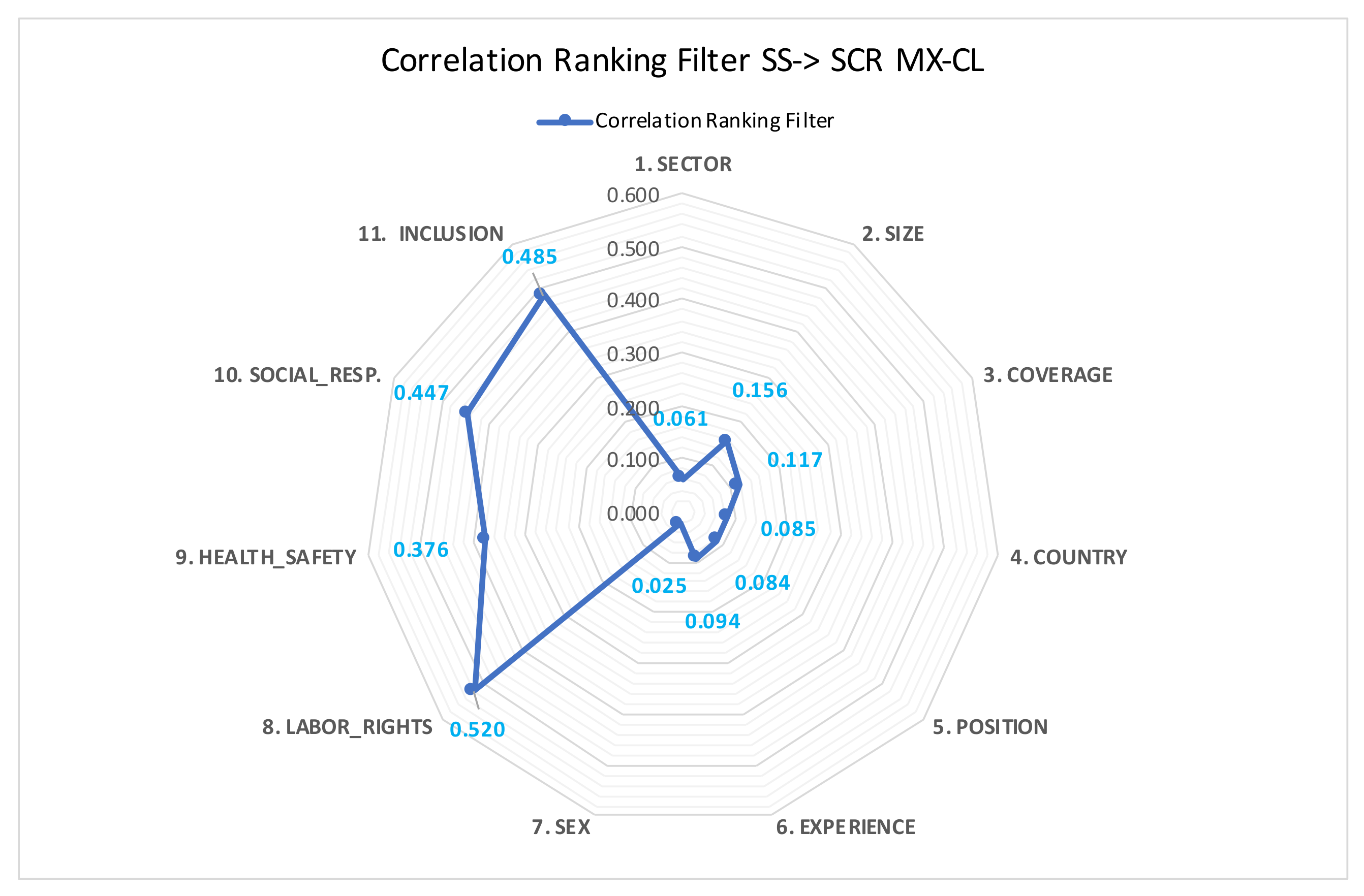
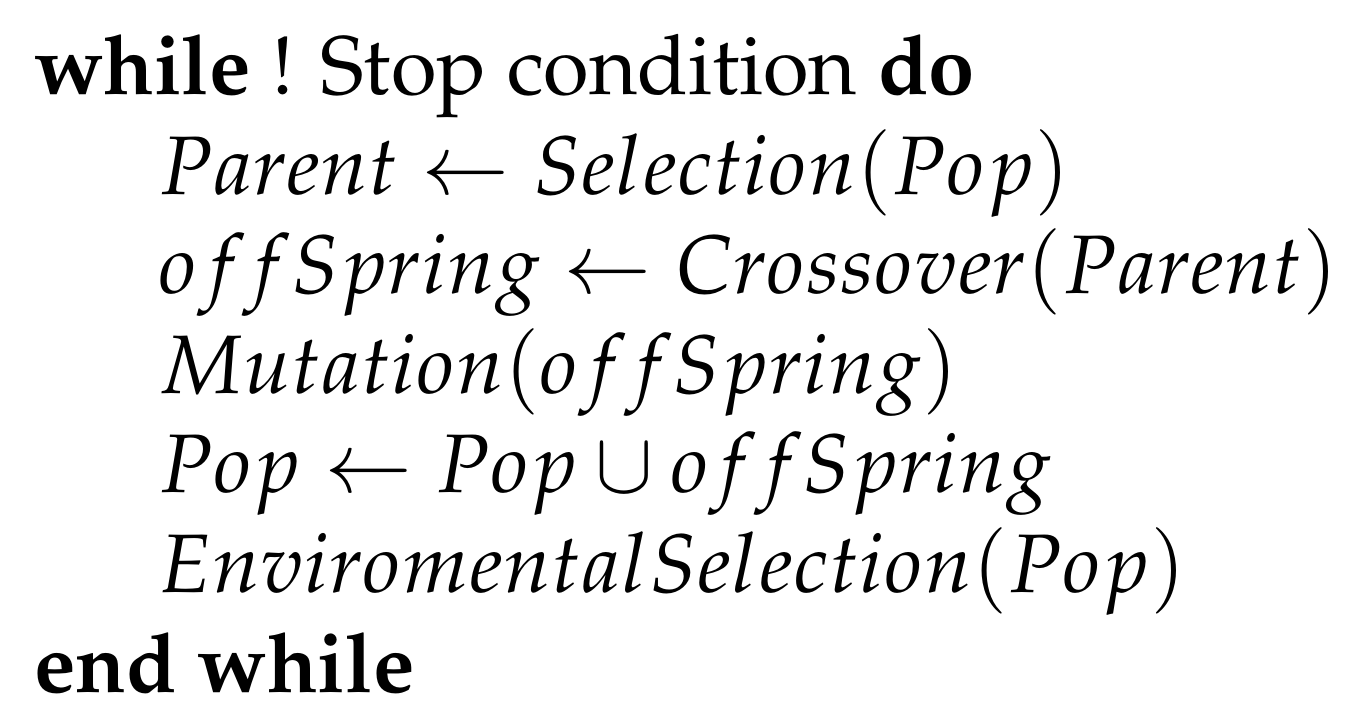

| Cite | Technique | Approach | Expert Knowledge | Systematic Configuration | AI | Aspects/Region |
|---|---|---|---|---|---|---|
| [18] | FIS | Decision-making | ✓ | ✓ | No | Social sustainability automotive sector in India. |
| [19] | FIS | Decision-making | ✓ | No | No | Social sustainability manufacturing sector. |
| [3] | Fuzzy Goal Programming | Optimization | ✓ | ✓ | No | Supply chain sustainability and resilience. China–Australia. |
| [15] | Fuzzy Multi-objective | Optimization | No | No | ✓ | Green supply chain. |
| [16] | Fuzzy Multicriteria | Decision-making | ✓ | ✓ | No | Sustainable urban transportation in Brazil |
| [24] | Fuzzy Multi-Objective | Optimization | ✓ | ✓ | No | Sustainable supply chain networks. |
| [25] | Fuzzy DEMANTEL-ANP | Decision-making | ✓ | ✓ | No | Sustainable project management in construction. |
| [17] | FIS | Decision-making | ✓ | ✓ | No | Transportation sustainability index in Serbia industry. |
| [26] | FIS | Decision-making | ✓ | No | No | Corporate sustainable European automotive case. |
| [27] | Fuzzy AHP | Decision-making | No | ✓ | No | Supply chain economic and social sustainability |
| [20] | FIS | Decision-making | ✓ | ✓ | No | Social sustainability in construction industry. |
| [21] | Fuzzy DEMATEL | Decision-making | ✓ | ✓ | No | Social sustainability in construction projects. |
| [28] | Fuzzy AHP | Decision-making | ✓ | ✓ | No | Social sustainable supply chain automotive sector in Turkey. |
| [22] | Fuzzy Mathematical Programming | Optimization | ✓ | ✓ | No | Resilience and sustainable supply chain Iran |
| [14] | Fuzzy AHP/Fuzzy TOPSIS | Decision-making | ✓ | ✓ | No | Sustainable supply chain logistics Vietnam. |
| [29] | Fuzzy multi-objective | Optimization | ✓ | ✓ | No | Resilience and sustainable supply chain. |
| [23] | Fuzzy Mathematical Programming | Optimization | No | ✓ | No | Resilience and sustainable healt care supply chain. |
| This work | Evolutionary Fuzzy Knowledge | Machine Learning | No | No | ✓ | Social sustainability and resilience Mexico/Chile. |
| Characteristic | Classification | Frequency | % |
|---|---|---|---|
| Country | Chile | 71 | 47.02 |
| Mexico | 80 | 52.98 | |
| Total | 151 | 100 | |
| Size | Large | 97 | 64.24 |
| Medium | 19 | 12.58 | |
| Small | 21 | 13.91 | |
| Micro | 14 | 9.27 | |
| Total | 151 | 100 | |
| Commercial coverage | Global | 50 | 33.11 |
| Latin America | 21 | 13.91 | |
| Local/regional | 20 | 13.25 | |
| National | 60 | 39.74 | |
| Total | 151 | 100 | |
| Experience in years in supply chain | 0–5 | 45 | 29.80 |
| 6–10 | 18 | 11.92 | |
| 11–20 | 36 | 23.84 | |
| ≥20 | 33 | 21.85 | |
| Total | 151 | 100 | |
| Sex | Male | 54 | 35.76 |
| Female | 97 | 64.24 | |
| Total | 151 | 100 |
| GA | |
|---|---|
| Crossover: | Single-point |
| Crossover probability: | |
| Mutation: | Random value |
| Mutation probability: | |
| Population size: | 100 |
| Generations: | 250 |
| Construct | Loads () | Cronbach () | Composite Reliability | AVE |
|---|---|---|---|---|
| I. Social Sustainability (, ) | 0.856 | 0.903 | 0.699 | |
| 1. Labor rights in SC | 0.873 | |||
| 2. Healt and safety in SC | 0.789 | |||
| 3. Social responsability in SC | 0.812 | |||
| 4. Inclusion in SC | 0.867 | |||
| II. Resilience in SC (, ) (HTMT, ) | 1.000 | 1.000 | 1.000 |
| AND Antecedents | Consequent | |||
|---|---|---|---|---|
| Labor-Rights | Social-Responsibility | Inclusion | Social-Security | Resilience-Supply-Chain |
| Low | Low | Low | Low | Low |
| Low | Low | Low | Mid | High |
| Low | Low | Low | High | Low |
| Low | Low | Mid | Low | High |
| Low | Low | Mid | Mid | Low |
| Low | Low | Mid | High | Mid |
| Low | Low | High | Low | Mid |
| Low | Low | High | Mid | Low |
| Low | Low | High | High | High |
| Low | Mid | Low | Low | High |
| Low | Mid | Low | Mid | Mid |
| Low | Mid | Low | High | Low |
| Low | Mid | Mid | Low | Mid |
| Low | Mid | Mid | Mid | Low |
| Low | Mid | Mid | High | Low |
| Low | Mid | High | Low | Mid |
| Low | Mid | High | Mid | High |
| Low | Mid | High | High | Mid |
| Low | High | Low | Low | Mid |
| Low | High | Low | Mid | High |
| Low | High | Low | High | High |
| Low | High | Mid | Low | High |
| Low | High | Mid | Mid | Low |
| Low | High | Mid | High | Mid |
| Low | High | High | Low | Mid |
| Low | High | High | Mid | High |
| Low | High | High | High | Mid |
| Mid | Low | Low | Low | Low |
| Mid | Low | Low | Mid | Low |
| Mid | Low | Low | High | High |
| Mid | Low | Mid | Low | Low |
| Mid | Low | Mid | Mid | Mid |
| Mid | Low | Mid | High | Mid |
| Mid | Low | High | Low | Low |
| Mid | Low | High | Mid | High |
| Mid | Low | High | High | High |
| Mid | Mid | Low | Low | Low |
| Mid | Mid | Low | Mid | High |
| Mid | Mid | Low | High | High |
| Mid | Mid | Mid | Low | High |
| Mid | Mid | Mid | Mid | High |
| Mid | Mid | Mid | High | High |
| Mid | Mid | High | Low | Mid |
| Mid | Mid | High | Mid | High |
| Mid | Mid | High | High | High |
| Mid | High | Low | Low | Low |
| Mid | High | Low | Mid | High |
| Mid | High | Low | High | High |
| Mid | High | Mid | Low | High |
| Mid | High | Mid | Mid | High |
| Mid | High | Mid | High | Mid |
| Mid | High | High | Low | Mid |
| Mid | High | High | Mid | Mid |
| Mid | High | High | High | High |
| High | Low | Low | Low | High |
| High | Low | Low | Mid | Mid |
| High | Low | Low | High | Mid |
| High | Low | Mid | Low | Mid |
| High | Low | Mid | Mid | High |
| High | Low | Mid | High | High |
| High | Low | High | Low | Low |
| High | Low | High | Mid | Low |
| High | Low | High | High | High |
| High | Mid | Low | Low | Low |
| High | Mid | Low | Mid | High |
| High | Mid | Low | High | High |
| High | Mid | Mid | Low | Mid |
| High | Mid | Mid | Mid | High |
| High | Mid | Mid | High | High |
| High | Mid | High | Low | Mid |
| High | Mid | High | Mid | High |
| High | Mid | High | High | High |
| High | High | Low | Low | Low |
| High | High | Low | Mid | Low |
| High | High | Low | High | High |
| High | High | Mid | Low | Low |
| High | High | Mid | Mid | Mid |
| High | High | Mid | High | High |
| High | High | High | Low | Low |
| High | High | High | Mid | Mid |
| High | High | High | High | High |
Publisher’s Note: MDPI stays neutral with regard to jurisdictional claims in published maps and institutional affiliations. |
© 2022 by the authors. Licensee MDPI, Basel, Switzerland. This article is an open access article distributed under the terms and conditions of the Creative Commons Attribution (CC BY) license (https://creativecommons.org/licenses/by/4.0/).
Share and Cite
Reyna-Castillo, M.; Santiago, A.; Martínez, S.I.; Rocha, J.A.C. Social Sustainability and Resilience in Supply Chains of Latin America on COVID-19 Times: Classification Using Evolutionary Fuzzy Knowledge. Mathematics 2022, 10, 2371. https://doi.org/10.3390/math10142371
Reyna-Castillo M, Santiago A, Martínez SI, Rocha JAC. Social Sustainability and Resilience in Supply Chains of Latin America on COVID-19 Times: Classification Using Evolutionary Fuzzy Knowledge. Mathematics. 2022; 10(14):2371. https://doi.org/10.3390/math10142371
Chicago/Turabian StyleReyna-Castillo, Miguel, Alejandro Santiago, Salvador Ibarra Martínez, and José Antonio Castán Rocha. 2022. "Social Sustainability and Resilience in Supply Chains of Latin America on COVID-19 Times: Classification Using Evolutionary Fuzzy Knowledge" Mathematics 10, no. 14: 2371. https://doi.org/10.3390/math10142371
APA StyleReyna-Castillo, M., Santiago, A., Martínez, S. I., & Rocha, J. A. C. (2022). Social Sustainability and Resilience in Supply Chains of Latin America on COVID-19 Times: Classification Using Evolutionary Fuzzy Knowledge. Mathematics, 10(14), 2371. https://doi.org/10.3390/math10142371








